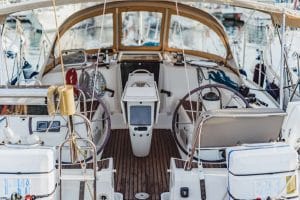Have you ever gotten lost or disoriented on the high seas? Do you know the nautical sextant? It is a tool that has gotten many of us out of trouble on more than one occasion and, although it is a utensil with a lot of history, its function is still as relevant as ever.
Learning to use it is, without a doubt, one of the more practical knowledge of navigation that we can obtain in this area.
What is the nautical sextant?
The nautical sextant is an instrument used to measure the angular separation between two points, like a star and the horizon - this is the most common use of this tool - or two different parts of a coast. It is a tool widely used in nautical, where it also has its origin, but it has other applications outside the sea.
Its existence is due to the combination of other older instruments used for the same purpose, but whose results offered less precision, such as the quadrant and the astrolabe. It is estimated that was invented in the 18th century, but it has evolved over time to adapt to the diverse use needs of each environment. Today the nautical sextant is one of the Mandatory elements on boats.
What is the nautical sextant used for in navigation?
The nautical sextant has always been used in the field of navigation -because that is where it initially began to be used-, and in the astronomical field, and its usefulness lies in the study of the movement of stars and planets and the preparation of celestial maps, since it accurately measures the position of the stars.
Nevertheless, Its most practical use is to find out where we are in the sea, since by making certain calculations we can obtain our exact latitude, that is, the distance that separates us from the equator.
Applications of the nautical sextant outside of navigation
As we say, the sextant measures the angular distance between two points, which is why it has also ended up being useful in other fields far from the sea and the stars. In geodesy and topography this instrument has a great practical application given its precision when measuring different heights and distances.
Parts of the nautical sextant
As we can guess, The nautical sextant is a complex instrument, composed of different elements that offer a result by combining their characteristics. To understand how the sextant works, it is convenient to know each of these pieces and understand their purpose in this framework. So, let's see what the main elements of a sextant consist of - there may be some more depending on the manufacture:
- He mirror -nowadays it is common to see sextants with several mirrors with different functions- it is used to see the object without having to look at it.
- He eyepiece or viewfinder It is the sight through which it is observed when using the nautical sextant.
- He limbus or graduated arc It is a numbered scale through which we obtain measurements.
- He vernier It is an additional scale used in measuring fractions of a degree.
- He index It is a sliding piece that holds the mirror and allows us to place it exactly where we need.
- He frame It is the base piece that supports and unites the rest of the pieces of the nautical sextant.
Are you interested in:
How to use the nautical sextant
The most common use of the nautical sextant if we are sailing is to measure our exact latitude when we are in the middle of the ocean. To locate the position we need to take four small steps in the use of this tool, which are as follows.
First step, observe
Before using the sextant we must choose a celestial body. Usually the sun and moon are chosen because they are the easiest to find, but the truth is that any star or planet would also work. Once the celestial body has been selected, we point at it with the viewer and observe it.
Second step, align the sextant
To align the sextant we need that the celestial body we are observing is located at the height of the horizon. We must bring the lower part of the star until it is on the horizon line, something we will do by sliding the mirror of the tool until we see that it is in this position.
Third step, take the measurement
The third step is take the measurement of the angle between the celestial body and the horizon, for which we will use the graduated arc. In this step it is necessary to slide the limb itself until the star is reflected in the mirror and appears on the graduated scale.
Fourth step, do the calculation
Usually, to calculate the exact angle we can resort to nautical formulas that we have on hand on the boat, there is no need to memorize them or interpret the data directly. There are tables that help us understand the latitude in which we are based on the measurement results offered by the nautical sextant.
The semimeridian formula to calculate the nautical sextant
Nevertheless, One of the most used formulas when obtaining latitude from a sextant is the semimeridian. To calculate it we need to previously obtain from nautical tables the declination of the celestial object - the angle at which it is located with respect to the celestial equator -, and the angular height of the object - obtained with the sextant - since the formula is the following:
90º – Angular height of the object + Declination of the object
Why learn to use the nautical sextant?
As we have seen throughout the article, the nautical sextant is a truly useful instrument in the field of navigation, since it can help us orient ourselves at a given moment if we get lost in the ocean. Ultimately, it is about one more tool that gives us greater security and independence when we are on the high seas.




